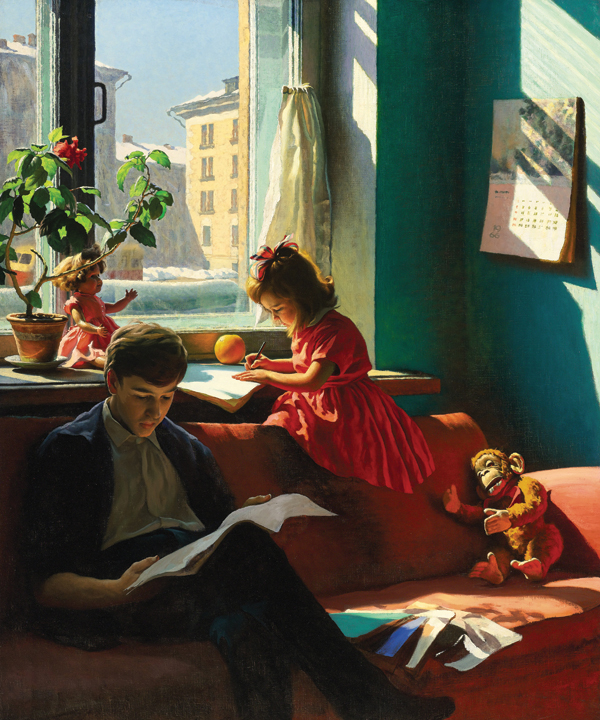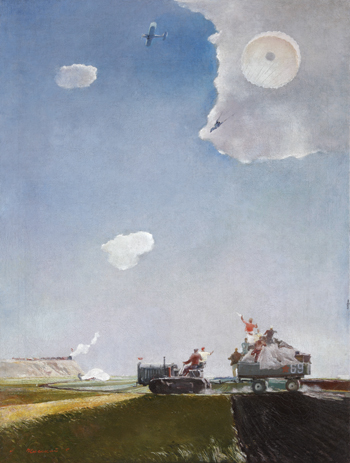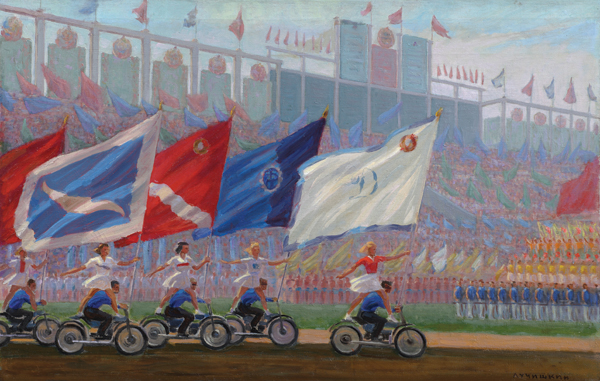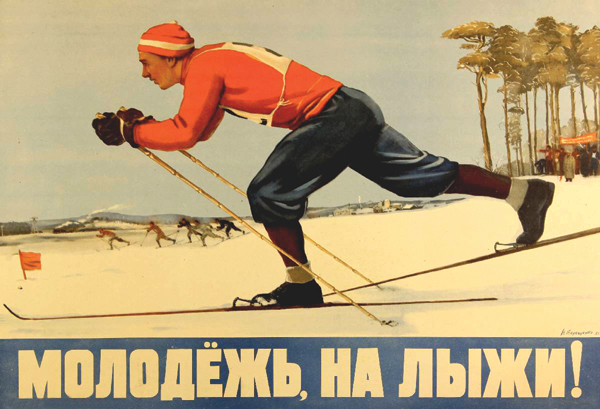Socialist Realism’s Russian Renaissance
Champions of Socialist Realism are seeking to restore it to what they see as its rightful place in Russian art history. But even as it attracts billionaire collectors and appears in prominent exhibitions, some ask whether the official style of Stalin can overcome its past
It was one of the most heralded openings of Moscow’s winter season. Artists, curators, and critics nibbled at macaroons and sipped champagne as they gazed at the canvases before them.
“It’s a real breakthrough,” said one artist. “The effect is stunning,” wrote Tatiana Markina in the Russian newspaper Kommersant. But what caused the excitement was not an emerging talent. It was Socialist Realism, the style set forth by Stalin 80 years ago to trumpet the worker state.
As Lenin statues were dismantled across Eastern Europe in the 1990s, savvy Western collectors such as Raymond E. Johnson of Minneapolis snapped up communist-era canvases at bargain prices. In the former Soviet Union, however, Socialist Realist artworks were the uneasy relics of a vanished civilization. The style was largely written off as kitsch, the stuff of posters and magnets sold to tourists.
Over the past several years, however, the tide has shifted. Two Russian oligarchs have founded collections dedicated to Socialist Realist art and have staged exhibitions such as “Soviet Art. Soviet Sport,” the show that caused such a stir in Moscow. Meanwhile, Socialist Realist works are selling at auction for increasingly high prices. In 2010, Yuri Pimenov’s First of May Celebration (1950) fetched $1.5 million at Sotheby’s London, thought to be the current record for a Socialist Realist painting.

Alexander Laktionov’s Visiting My Grandmother, 1930, sold at Sotheby’s London in 2011 for $400,000. COURTESY SOTHEBY’S
Socialist Realism’s champions seek to restore it to what they see as its rightful place in the history of art. But Stalinist esthetics raise thorny questions. Is Socialist Realism, as collectors see it, a viable alternative to Western modernism, unfairly overshadowed by the Iron Curtain? Or is it mere propaganda, destined to remain on history’s back pages?
The Soviet state inaugurated Socialist Realism in art in 1932 and elaborated its principles two years later at the Congress of Soviet Writers. The precepts were clear: Soviet art was to be for and about workers and depict an idealized version of everyday life. It was to be representational (no bourgeois abstraction), and advance the Communist Party line. Black squares were out; muscled workers were in. Artists either entered the fold or were wiped from history.
For some artists, it wasn’t much of a stretch. Realist painters such as Isaak Brodsky and Alexander Gerasimov—Stalin’s favorite artist and the creator of his most famous portraits—continued working in the same style they had mastered before the revolution while experiencing a tremendous increase in funding and prestige. Meanwhile, uncompromising abstractionists such as Kazimir Malevich faded into oblivion, excised from exhibitions and books.
By the 1960s, Socialist Realism had reached a dead end, cannibalized by the horrifying realities of repression and war. A number of the artists who came of age during Khrushchev’s Thaw, from the mid-1950s to the early ’60s, pioneered a new kind of realism. Known as the Severe Style, it allowed for humanism to pierce official art’s utopian armor. While the state never allowed it to bloom fully, the Severe Style produced several bright talents, including cult hero Viktor Popkov.
The man working the crowd at the “Soviet Sport” opening was Alexei Ananyev, whose fortune is estimated at $2 billion. An imposing bearded figure, Ananyev is an IT magnate and the chairman of Promsvyazbank. The show was his brainchild, and it was taking place at his Institute of Russian Realist Art, which Ananyev opened in late 2011 on the basis of his collection. “Soviet Sport” debuted last December at Sotheby’s London and was well received.
Ananyev sees Socialist Realism as a historical Russian style, inherited from such 19th-century masters as Ilya Repin. “There is a century-long academic tradition, which fortunately for this art has been transferred from one generation of painters to another and preserved,” Ananyev said. He was standing in front of an enormous oil painting of Stalin’s defense commissar Kliment Voroshilov, depicted skiing merrily through the woods.
The New Russian billionaires are patronizing the arts with enthusiasm, in the tradition of such prerevolutionary businessmen as Ivan Morozov and Pavel Tretyakov. Ananyev’s rival in Socialist Realist collecting is Andrei Filatov, a transportation mogul and chess fanatic. In 2012, Filatov founded the Filatov Family Art Fund, with the aim of collecting Soviet realist art and displaying it at home and abroad.
The Filatov Fund currently holds around 150 works, including portraits by Nicolai Fechin and a model of Vera Mukhina’s famed Worker and Kolkhoz Woman sculpture for the 1937 World’s Fair in Paris. According to managing director Rena Lavery, the collection grows by 10 to 15 pieces each year. Last winter, the foundation staged a Moscow exhibition of Filatov’s favorite artist, Popkov, which was accompanied by the release of the first major English-language book about the artist. After appearing in Venice, the show is scheduled to debut in London’s Somerset House on May 20.

Soviet man conquers the skies in Georgy Nissky’s A Parachute Jump, 1930s, from “Soviet Art. Soviet Sport.” COURTESY INSTITUTE OF RUSSIAN REALIST ART, MOSCOW
Wealthy collectors are “ready to finance this art, and they’re ready to show it to the masses, not just enjoy it for themselves,” said Natalia Alexandrova, head of the postwar painting department at the State Tretyakov Gallery in Moscow. If it weren’t for Filatov, she added, the Tretyakov’s Popkov paintings would never have seen the light of day.
Ananyev is 49, and Filatov is 42. For both men, realism is a memento of their youth—Ananyev dabbled in it himself as a young art student—and a model of what art should be. According to Ananyev, the “emotion” of realist painting distinguishes it from other modern movements such as Hyperrealism, which, he says, exhibits “excellence in craftsmanship, in mastering the colors and drawing, but there is no soul.” Conceptual art, he believes, is overintellectualized. “Real art doesn’t require explanation,” he said.
There is also simple nostalgia. According to Frances Asquith, director of the Russian pictures department at Sotheby’s, domestic scenes are doing very well among collectors in Russia and the Commonwealth of Independent States. One recent painting on the auction block was Visiting My Grandmother (1930) by Alexander Laktionov, depicting two children and a toy stuffed monkey in a sunny apartment.
“The response we got from that picture was extraordinary,” Asquith said. It brought $400,000, double the expected price.
“Socialist realism is nothing but an attempt to stuff intellectual or dogmatic objectives into art,” the British critic Herbert Read famously stated. Read compared the Soviet dislike of modernism to the conservative tastes of the Third Reich.
Over the last two decades, Western galleries such as Raymond Johnson’s Museum of Russian Art in Minneapolis and the Museum Ludwig in Cologne, Germany, have turned away from Read’s interpretation, placing Socialist Realism within the greater tradition of Russian painting. But interest in Socialist Realist works has only emerged in the former Soviet bloc in the past four or five years, Asquith said.
“I think the negative charge has gradually ebbed away a bit,” she said. “Very often it was a period that was damned on ideological grounds, rather than serious critical judgment.”
One of Socialist Realism’s greatest marvels, Asquith noted, is merely that it exists at all. While realism was largely abandoned in the West in the 20th century, the Soviet state was devoting vast resources to supporting traditional landscape and portrait artists.
Some of the work demonstrates great skill. “There’s a casual assumption that the paintings were mechanical in technique,” Asquith said, the product of a regime that valued quantity over quality. “But on further scrutiny, you see surprising boldness and intensity. It’s a very malleable genre.”
One of the highlights of Ananyev’s collection is Georgy Nissky’s A Parachute Jump, which dates from the 1930s. Its subject, “Soviet man conquering the skies,” lies firmly within official parameters. Nissky’s execution, however, is exhilarating. A low-slung horizon of men and women on tractors sweeps up to a blue sky intersected by a parachute, while a passing cloud casts a shadow across much of the frame.
One of the greatest masters of Socialist Realism was Alexander Deineka (1899–1969), whose sultry nudes transcended the state’s asexual self-image. In the ’60s, Popkov took up his mantle. Beyond pioneering the Severe Style, exemplified by his Builders of Bratsk (1960), Popkov made colorful experiments in abstraction, as well as psychologically penetrating domestic scenes. Tragically, his career was cut short in 1974, when he was shot dead in Moscow at age 42 by the driver of an armored car who mistook him for a robber.

Sergey Luchishkin, An Athletes’ Parade at the Dynamo Stadium, 1936—76. COURTESY INSTITUTE OF RUSSIAN REALIST ART, MOSCOW
Though Popkov’s depictions of workers and construction sites entered the official canon—and won the Grand Prix at the 1967 World Biennale in Paris—his expressive style earned him regular rebukes, and is only now being examined in full.
For all Soviet artists’ creativity, officialdom was never far away. Most painters were charged with producing paeans to the Central Committee. Isaak Brodsky’s monumental canvas of a skiing Voroshilov could be any sporting scene, with a pastoral setting that nods to the Dutch Masters. But it was painted in 1937, the peak of Stalin’s repressions, when Voroshilov personally signed off on thousands of executions. The artist painted the canvas in a three-week fury, agonizing over whether to portray the military leader in a fur hat or a cap (he eventually went for the latter). Finding the right portrayal was a matter of life and death.
Some galleries are keeping their distance from this complicated legacy. This summer’s Popkov show at Somerset House marks a change of venue from the original location, the Royal Academy. The latter backed out of the engagement last fall, issuing a statement that the exhibition did not “fit the requirements of the programme.”
“There are lots of problems associated with realism—persecution, suppression,” said Mikhail Izotov, an artist of the late Socialist Realist school whose works include Gymnasts: Portrait of Vladimir Artemov and Yuri Korolyov (1987), an Ananyev purchase. “It’s treated with irony.”
Some of that irony has been on display in the Russian press. “This is what the Tretyakov Gallery would look like if those damned democrats in the wild ’90s hadn’t taken control of the country,” quipped critic Valentin Dyakonov about “Soviet Sport.”
Some prefer to divorce Socialist Realist art from its historical context. “I don’t think you need to come in with that kind of outlook,” said Nadezhda Stepanova, a curator at the Institute of Russian Realist Art. The Filatov Fund’s Lavery agreed: “When you’re born is when you’re born; if you have a gift you have a gift,” she said. “I don’t see how the history matters.”
Acknowledging the ideological pressures of the time, however, can lead to a deeper appreciation of the artists who worked within their confines. Asquith compares Socialist Realism to Surrealism: “It’s a magical kingdom that in some ways had little to do with everyday life. They had to define something that didn’t exist.”
For many in the former Eastern bloc, Socialist Realist imagery can bring up painful questions of history and memory. Last year, as part of an exhibition titled “Myth: Ukrainian Baroque,” Kyiv’s National Art Museum of Ukraine displayed Stalin’s Toast: To the Great Russian People, a canonical 1946 painting by Mikhail Khmelko that portrays Stalin’s famous toast at the Kremlin.
The painting is a traditional sore spot for Ukrainians, who view it as Russia taking credit for the Soviet victory in World War II. But at the exhibition, it “really provoked a lot of thought and interest,” said Olesya Ostrovska-Lyuta, curator, art manager, and head of programs and projects of the oligarch Rinat Akhmetov’s Foundation for Development of Ukraine. “We might not be very happy that the avant-garde died and was replaced by Socialist Realism, but this is the art we had. We need to examine all the material, without exclusion.”

N.I. Tereshchenko’s 1951 poster urges Soviet youth to take to the slopes, from the “Sportcult” exhibition at Proun Gallery. COLLECTION OF ALLAN GAMBORG ANDERSON
As interest in Socialist Realism grows, there is plenty of material to choose from; state-sponsored artists were incredibly prolific. Now the task is to filter through it. The upswing in collecting will last 25 years, Lavery predicts, the normal arc for a new niche. Sotheby’s is currently selling between a dozen and two dozen Socialist Realist works per year.
Big names still get the million-dollar prizes, but lesser-known artists are starting to come to the forefront, such as Nissky and Viktor Tsvetkov, whose painting The Finish recently fetched $83,000 at Sotheby’s London. While the biggest markets are in the United States, Europe, and now Russia and the CIS, the style is also gaining a strong following in China and Japan.
Wealthy collectors remain the primary engine of the movement’s reappraisal, but small, contemporary galleries are also taking up the charge. The hip Moscow Design Museum, a project started in 2011 by Western-oriented young curators, staged its own exhibition of Soviet sports art, called “Sportcult,” at the Proun Gallery this winter.
Curator Darya Makarova said that Socialist Realism is now attracting the interest of younger Russians. “Of course, they understand this art through the prism of repression, but they look at the artists and their esthetics with fresh eyes,” she said.
They also appreciate Socialist Realism’s other, more primal appeal: “naked bodies,” Makarova said with a laugh. One poster at the show featured a buff water-polo player emerging from the pool, proclaiming, “There is no apparel finer than brawny muscles and dewy skin.”
Joy Neumeyer is a freelance journalist in Moscow.
A version of this story originally appeared in the May 2014 issue of ARTnews on page 68 under the title “Return to the Worker’s Paradise.”
Copyright 2014, ARTnews LLC, 48 West 38th Street, New York, N.Y. 10018. All rights reserved.
By Joy Neumeyer
Source: http://www.artnews.com